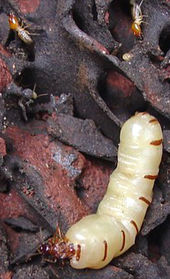Dictyoptera
| Dictyoptera | |
|---|---|

| |
| Temnopteryx sp. | |
| Scientific classification | |
| Domain: | Eukaryota |
| Kingdom: | Animalia |
| Phylum: | Arthropoda |
| Class: | Insecta |
| Cohort: | Polyneoptera |
| Superorder: | Dictyoptera Latreille, 1829 |
| Orders | |

Dictyoptera (from
Classification and phylogeny
The use of the term Dictyoptera has changed over the years, and while largely out of use for much of the last century, it is becoming more widely used. It has usually been considered a superorder, with Isoptera, Blattodea and Mantodea being its three orders. In some classifications, however, Dictyoptera is shifted to order status and in others the order Isoptera has been subsumed under Blattodea while retaining Dictyoptera as a superorder. Regardless, in all classifications the constituent groups are the same, just treated at different rank. Termites and cockroaches are very closely related, with ecological and molecular data pointing to a relationship with the cockroach genus Cryptocercus.[3][4]
According to genetic evidence, the closest living relatives of the Dictyoptera are the orders
Evolutionary relationships based on Eggleton, Beccaloni & Inward 2007 and modified by Evangelista et al. 2019, are shown in the
| Dictyoptera |
| ||||||||||||||||||||||||||||||||||||||||||||||||||||||||||||||||||||||||

References
Further reading
- Inward, Daegan; Beccaloni, George; Eggleton, Paul (22 June 2007). "Death of an order: a comprehensive molecular phylogenetic study confirms that termites are eusocial cockroaches". Biology Letters. 3 (3): 331–335. PMID 17412673.
